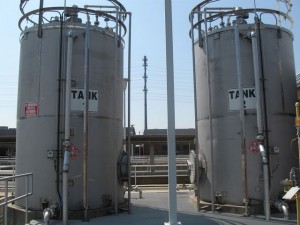 Chemicals are an everyday part of operating a biorefinery facility as we learned in Part 1 of Biorefinery Safety Series. Chemicals are also an integral part of biodiesel production. Therefore, it is vitally important that all employees at a biodiesel facility, whether a large operation on a small backyard operation, learn, practice and live safe methanol handling techniques. So today, Part 2 of the Biorefinery Plant Safety Series is going to look how to safely handle methanol.
Chemicals are an everyday part of operating a biorefinery facility as we learned in Part 1 of Biorefinery Safety Series. Chemicals are also an integral part of biodiesel production. Therefore, it is vitally important that all employees at a biodiesel facility, whether a large operation on a small backyard operation, learn, practice and live safe methanol handling techniques. So today, Part 2 of the Biorefinery Plant Safety Series is going to look how to safely handle methanol.
 To learn more, I spoke with Greg Dolan with the Methanol Institute. The association does a lot of work with the National Biodiesel Board because methanol is a key component in biodiesel production.
To learn more, I spoke with Greg Dolan with the Methanol Institute. The association does a lot of work with the National Biodiesel Board because methanol is a key component in biodiesel production.
A gallon of biodiesel is on average between 10-15 percent methanol, said Dolan who explained that you take the oil, could be soybean oil or vegetable oil, add methanol, then add a catalyst and you produce biodiesel. Part of the end product will be some waste methanol and some glycerin and with some production technologies, that methanol can be put back into the front end of the process.
What happens if you don’t handle the methanol safely? Things go boom.
Dolan said methanol is a flammable and toxic chemical and methanol has to be handled properly. “Some of the same precautions we use handling gasoline are also used in handling methanol. For instance, you need to use the proper materials for storage. There are specific guidelines for unloading and loading of methanol at a facility. You also need to pay attention from doing any hot work around any methanol storage. That is something you really want to stay away from. Most accidents we’ve seen at biodiesel facilities result in doing hot work around methanol storage,” he said.
Listen to my interview with Greg Dolan here: Ethanol Safety Series Part II: Methanol Safe Handling
For instance, if you have a methanol storage tank that may be a tote that holds 350 gallons, you don’t want to be doing things like using a torch around that tote or a drum. “For methanol, the real risk isn’t so much the methanol itself, but the vapors that come with methanol. And the vapors can ignite and then flashback to the storage container. So you really have to be careful of not using any sparking tools around methanol or a storage facility and watch out for vapors.”
 The Methanol Institute has a number of free guidance documents including a Methanol Safety Manual, a video, several technical bulletins that deal with methanol storage and will soon be releasing a new methanol safety newsletter. They are all FREE and you can access them at www.methanol.org.
The Methanol Institute has a number of free guidance documents including a Methanol Safety Manual, a video, several technical bulletins that deal with methanol storage and will soon be releasing a new methanol safety newsletter. They are all FREE and you can access them at www.methanol.org.
So how often should you revisit your safety procedures. Dolan said facilities really need to develop a culture of safety that safe handling is embedded into everything you do. Whether it’s using proper protective equipment and clothing, gloves, splash-proof glasses, hard hats, it really starts with things like the protective equipment employees use day in and day out. There should be regular training for plant operators. And one of the key things they suggest is for facilities is contact their local first responders.
Other tips? Facilities should have safety measures on site such as fire suppression systems, alcohol resistant foam for fire fighting and carbon monoxide detectors. When you combine safe handling, equipment, clothing, storage, and training, you can ensure that your plant doesn’t go boom.

